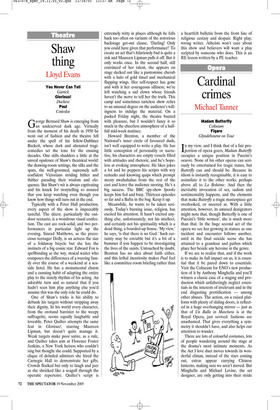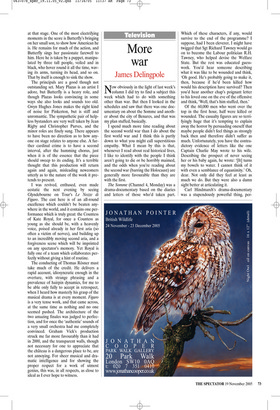Cardinal crimes
Michael Tanner
Madam Butterfly Coliseum Figaro Glyndebourne on Tour In my view, and I think that of a fair proportion of opera goers, Madam Butterfly occupies a unique position in Puccini’s oeuvre. None of his other operas can seriously be entertained for tragic status, but Butterfly can and should be. Because its idiom is instantly recognisable, it is easy to assimilate it to the other works, perhaps above all to La Bohème. And then the inevitable invocation of sex, sadism and sentimentality happens, and the elements that make Butterfly a tragic masterpiece get overlooked, or sneered at. With a little attention, however, its amused denigrators might note that, though Butterfly is one of Puccini’s ‘little women’, she is much more than that. In the huge second act of the opera we see her growing in stature as one incident and encounter follows another, until in the final suicide scene she has attained to a grandeur and pathos which place her beside any heroine in the genre.
If we are to realise that, and if the work is to make its full impact on us, it is essential that it be pared down to essentials. Visit the Coliseum for ENO’s new production of it by Anthony Minghella and you’ll witness a classic case of a staging and production which unfalteringly neglect essentials in the interests of irrelevant and in the end disgusting prettification — among other abuses. The action, on a raised platform with plenty of sliding doors, is reflected in a huge overhanging mirror — just as that of Un Ballo in Maschera is at the Royal Opera, just revived: fashions are unashamed. That gives everything a symmetry it shouldn’t have, and also helps our attention to wander.
There are lots of colourful costumes, lots of people wandering around the stage at the drama’s most intimate moments. As the Act I love duet moves towards its wonderful climax, instead of the stars coming out, extras appear carrying Chinese lanterns, making sure we aren’t moved. But Minghella and Michael Levine, the set designer, are only getting into their stride at that stage. One of the most electrifying moments in the score is Butterfly’s bringing on her small son, to show how American he is. He remains for much of the action, and Butterfly sings her passionate farewell to him. Here he is taken by a puppet, manipulated by three tall people, veiled and in black, who hover round it all the time, waving its arms, turning its head, and so on. That by itself is enough to sink the show.
The principals are a good though not outstanding set. Mary Plazas is an artist I adore, but Butterfly is a heavy role, and though Plazas looks convincing in some ways she also looks and sounds too old. Gwyn Hughes Jones makes the right kind of noise for Pinkerton, but is stiff and unromantic. The sympathetic pair of helpless bystanders are very well taken by Jean Rigby and Christopher Purves, and the minor roles are finely sung. There appears to have been no direction as to how anyone on stage relates to anyone else. A further cardinal crime is to have a second interval, after the humming chorus, just when it is of the essence that the piece should sweep to its ending. It’s a terrible thought that this production will return again and again, misleading newcomers utterly as to the nature of the work it pretends to present.
I was revived, enthused, even made ecstatic the next evening by seeing Glyndebourne on Tour’s Le Nozze di Figaro. The cast here is of an all-round excellence which couldn’t be beaten anywhere in the world, and it contains one performance which is truly great: the Countess of Kate Royal, for once a Countess as young as she should be, with a heavenly voice, poised already in her first aria (so often a victim of nerves), and building up to an incredibly moving second aria, and a forgiveness scene which will be imprinted on any spectator’s memory. Yet Royal is fully one of a team which collaborates perfectly without giving a hint of routine.
The conducting of Thomas Rösner must take much of the credit. He delivers a rapid account, idiosyncratic enough in the overture, with strange phrasing and a prevalence of hairpin dynamics, for me to be able only fully to accept in retrospect, when I heard how masterly his grasp of the musical drama is at every moment. Figaro is a very tense work, and that came across, at the same time as nothing and no one seemed pushed. The architecture of the two amazing finales was judged to perfection, and for once the ‘authentic’ sounds of a very small orchestra had me completely convinced. Graham Vick’s production struck me far more favourably than it had in 2000, and the transparent walls, though not necessary for one to appreciate that the château is a dangerous place to be, are not annoying. For sheer musical and dramatic intelligence and for showing the proper respect for a work of utmost genius, this was, in all respects, as close to ideal as I ever hope to witness.


























































 Previous page
Previous page